Understanding World Religions: New on the Next Christians Reading List
 Honestly, if you would have told me 25 years ago that I’d need a resource that would help me understand world religions, I’d probably have rolled my eyes and said, “I have no plans to be a missionary.” And I would have been expressing the mindset of most people I knew. Mind you, I grew up in Southern California and I had Muslim and Buddhist friends, but 25 years ago might as well have been a hundred.
Honestly, if you would have told me 25 years ago that I’d need a resource that would help me understand world religions, I’d probably have rolled my eyes and said, “I have no plans to be a missionary.” And I would have been expressing the mindset of most people I knew. Mind you, I grew up in Southern California and I had Muslim and Buddhist friends, but 25 years ago might as well have been a hundred.
America in the 70s and 80s was really just at the beginning of a multi-cultural, multi-ethnic tidal wave and is a very different place today. In the 70s and 80s, America still had a decidedly Christian worldview. Although the UK and the rest of the Western world had begun to tip, it was still the norm for most Americans to think of other world religions as being “over there.” In 2011 we live in a very different culture, post-Christian America, and developing an understanding of other world religions is essential.
6 weeks ago when Ed Stetzer interviewed Irving Hexham about his new book, Understanding World Religions, it seemed like a natural fit for my Next Christians reading list. After spending the last few weeks looking it over…I can tell you it’s going to turn out to be a great resource.
Understanding World Religions: An Interdisciplinary Approach by Irving Hexham is pitched just right for most of us. Although Hexham, Professor of Religious Studies at the University of Calgary and adjunct professor of World Christianity at Liverpool Hope University has published numerous academic books and articles on the subject, this one really doesn’t have an academic feel. Instead, it has the feel of a fascinating and almost uncensored sit-down conversation with a brilliant story-telling world religion expert.
At just over 500 pages, it’s a thorough presentation of the major world religions. A little surprisingly to me, Hexham spends 60 pages on African religions. Who knew it would make sense to include such a lengthy piece on African witchcraft, sorcery and the Zulu view of God! But…after you work your way through the section…it makes total sense!
There’s also very healthy sections on what Hexham refers to as the Yogic Traditions (Hinduism and Buddhism) as well as what he calls the Abramic Tradition (Judaism, Christianity, and Islam). Every section’s makeup is unique and not formulaic in the least; reflecting the unique aspects of each religion. In one of the most engaging aspects of each section, there is also a fascinating collection with a biographical slant about important players within the developing religion.
One of the most interesting aspects of Understanding World Religions proved to be the author’s freedom to offer nearly uncensored opinion. This is a decidedly unique aspect of a religion and provides a spark or two. I can only imagine how effective it will be as a college or continuing education textbook.
Looking for a way to get up to speed on the beliefs and more importantly, on the worldview of representatives of the other major religions? You might want to pick up a copy of Understanding World Religions. It’s no longer an “over there” conversation. This book could be just the thing you’re looking for as you work to get to know your neighbors.


High quality
Office Furniture
casegood products for the North American market. We are headquartered
in the City of Industry, California. And we ship directly from our
dedicated 50,000 sq. ft. capacity each central distribution warehouses
facilities located in the City of Commerce, California and also our
recently expanded second dedicated 50,000 sq. ft.